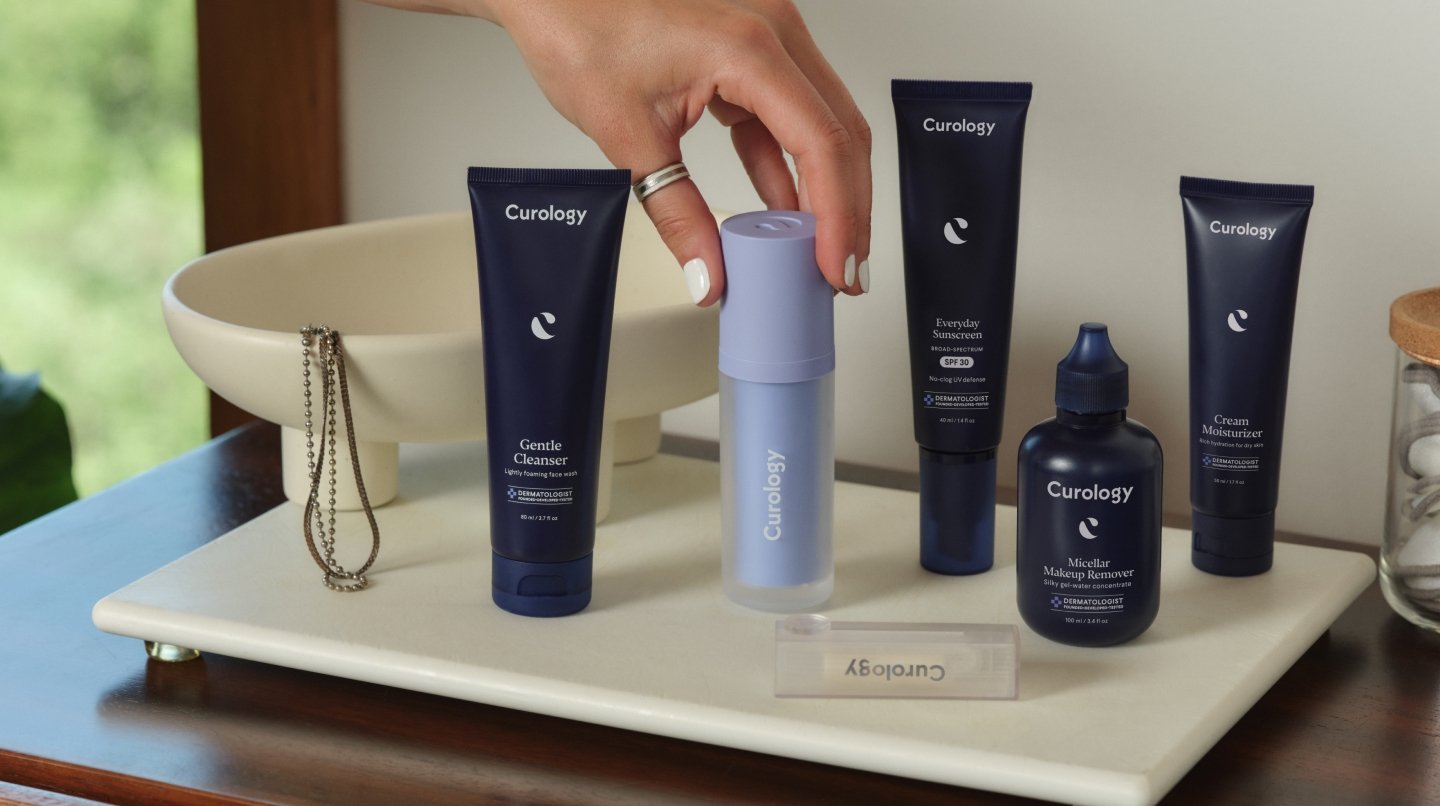How it works:
Share your skin goals and snap selfies
Your dermatology provider prescribes your formula
Apply nightly for happy, healthy skin
How it works:
How it works:
Share your skin goals and snap selfies
Your dermatology provider prescribes your formula
Apply nightly for happy, healthy skin
How it works:
5 ingredients you may want to avoid in your skincare products
Learn which ingredients you may want to avoid in your products.



Could your skincare routine be doing more harm than good? Depending on the products you use, you may unknowingly be exposing yourself to potentially harmful ingredients on a daily basis.
It’s important to understand what ingredients are in your products!
We’re here to help! Curology’s skincare experts will explain what you need to know about the most common ingredients found in skincare that you may want to avoid and their potential risks.
Why are potentially toxic ingredients used in skincare?
The global cosmetics industry has witnessed remarkable growth over the past few years and is expected to continue its upward trajectory in the coming years. With a global market value of approximately $262 billion USD in 2022,¹ the cosmetics industry is one of the fastest-growing in the world. However, this growth has also brought with it a growing concern about the safety of cosmetic products and their potential impact on human health.
Potentially toxic ingredients are used for many different reasons. Take preservatives such as parabens for instance. These ingredients are used to extend the shelf life of skincare and cosmetic products by preventing microbial growth and oxidation—but they’ve also been linked to potential health risks. This has led cosmetic manufacturers to introduce alternative preservatives that are marketed as being safer and “more natural,” but continued innovation and investment in research and development is still required to find safe and effective alternatives to traditional preservatives.²
Common toxic ingredients in skincare products
Many cosmetics on the market today contain potentially harmful ingredients. Here are some common ones used in skincare.
Parabens
Parabens are commonly used as preservatives in cosmetics and beauty products such as moisturizers, deodorants, toothpastes, and makeup, due to their antimicrobial properties. They can be dissolved in various substances except for water and have both benefits and side effects.³
Benefits include their antimicrobial properties, low production costs, and chemical stability. However, concerns have been raised about their safety due to their potential as reproductive and endocrine disruptors, as well as their potential to increase the risk of breast cancer and cause allergic reactions.⁴
Studies on animals and humans have produced conflicting results. Despite some studies indicating negative effects on the body, it is unclear whether the concentrations found in cosmetic products pose a risk to humans. Therefore, more research is needed to clarify the potential toxic effects of parabens and to determine their safety for use in consumer products. The FDA has set permissible limits of parabens that can be present in individual goods.⁵
Sodium lauryl sulfate
Sodium lauryl sulfate (SLS) is commonly used as a surfactant in skincare products to help cleanse the skin.⁶ It can be found in a variety of products such as facial cleansers, body washes, and shampoos. It helps to create a foaming lather and emulsifies oils and dirt on the skin's surface, making it easier to rinse away. However, SLS can also be irritating to the skin, especially at higher concentrations, and can disrupt the skin's natural barrier function by increasing water loss and decreasing natural moisturizing factors.⁷
Mineral oil
Mineral oils and waxes are commonly used in cosmetics for their ability to regulate the thickness of a product, moisturize the skin, and provide a protective layer that helps prevent dehydration. They are stable and generally well-tolerated by the skin, making them an ideal ingredient for a wide range of products, including skin creams, sunscreens, lip care, and hair gels. The amount of mineral oils used in cosmetics varies depending on the specific product, with concentrations ranging from as little as 1% to as much as 99%.⁸
Overall, mineral oils and waxes are versatile and generally safe ingredients that are widely used in the cosmetic industry.⁹ Mineral oils are generally recognized as safe by the FDA as a skin protectant drug product for over-the-counter use.¹⁰ However, there have been instances where the use of mineral oils are susceptible to contamination with polycyclic aromatic hydrocarbons, which can lead to skin allergies and irritation. Consuming natural mineral oil is toxic because it settles and accumulates in the stomach.¹¹
Phthalates
Phthalates are a group of chemical compounds with a wide range of applications, including their use as solvents in skincare and cosmetic products. They can be found in various personal care products, such as skin moisturizers, nail polish, and sealants. Despite their versatility and prevalence in these products, studies have linked phthalates to adverse health effects when they come into direct contact with the skin, hair, nails, and mucous membranes.¹²
Studies suggest that phthalates can cause endocrine disruption and reproductive issues, among other negative health effects. For example, phthalates may disrupt the body's endocrine system, and may contribute to developmental and reproductive problems.¹³ Additionally, they have also been associated with asthma, obesity, and diabetes.¹⁴ However, based on currently available information and data, the FDA does not have safety issues with phthalates as they’re currently used in cosmetics and fragrances.¹⁵
Oxybenzone
Oxybenzone, a common ultraviolet (UV) filter found in many pharmaceutical and cosmetic products, is used to provide protection against the harmful effects of UV radiation. These UV filters are important components of sunscreen and personal care products, helping to prevent skin damage caused by UV radiation.¹⁶
Despite being widely used, there are concerns about the safety of oxybenzone, and there may be potential side effects associated with its use.
A randomized clinical trial to study absorption of six active ingredients found in sunscreens, including oxybenzone, found that they were systematically absorbed and had plasma concentrations exceeding the FDA threshold.¹⁷ In light of this, the FDA has recommended additional safety studies on oxybenzone, but it has not yet deemed the use of oxybenzone as unsafe.¹⁸ In response to these concerns, many consumers choose to avoid products that contain oxybenzone, and there has been a growing demand for alternatives.

A skincare solution for you
The growing concern over toxic ingredients in skincare products is a reflection of consumers' increasing awareness of the impact of these products on their health and the environment.
Fortunately, there are safer and more sustainable alternatives available that avoid the use of certain harmful ingredients. You can take control of what you put on your skin by reading product labels. By doing so, you can reduce your exposure to potentially harmful ingredients and support the use of sustainable skincare products.
Get your personalized skincare routine with Curology
Get your personalized skincare routine with Curology


With Curology, you can take advantage of the expertise of licensed dermatology providers to find safe and effective skincare options to help you reach your skin goals. Making informed choices about skincare is an important aspect of maintaining your overall health and well-being.
You don’t have to go at it alone. Consult with our licensed dermatology providers by signing up for a 30-day trial* and start your personalized skincare journey today!
FAQs
Skincare ingredients that may be considered harmful and that some consumers may wish to avoid include parabens and sodium lauryl sulfate.
Many materials may be absorbed through the skin in significant amounts. Examples of these include mercury, isocyanates, polychlorinated biphenyls (PCBs), acrylates, and pharmaceutical products such as steroids and nicotine.¹⁹
Generally, you may prefer skincare products to be free of dyes, parabens, fragrance, lanolin and formaldehyde.²⁰
P.S. We did the homework so you don't have to:
Grand View Research. Cosmetics Market Size, Share & Trends Analysis Report By Product (Skin Care, Hair Care, Makeup, Fragrance), By End-user (Men, Women), By Distribution Channel, By Region, And Segment Forecasts, 2023-2030. (n.d.).
Nowak, K. et al. Controversy around parabens: Alternative strategies for preservative use in cosmetics and personal care products. Environmental Research. (July 2021).
Alaba, P.A.A., et al. Toxic Effects of Paraben and its Relevance in Cosmetics: A Review. International Journal of Research Publication and Reviews. (May 2022).
Alaba, P.A.A., et al. Toxic Effects of Paraben and its Relevance in Cosmetics: A Review. International Journal of Research Publication and Reviews. Ibid.
Alaba, P.A.A., et al. Toxic Effects of Paraben and its Relevance in Cosmetics: A Review. International Journal of Research Publication and Reviews. Ibid.
Leoty-Okombi, S., et al. Effect of Sodium Lauryl Sulfate (SLS) Applied as a Patch on Human Skin Physiology and Its Microbiota. Cosmetics. (2021, January 6).
Leoty-Okombi, S., et al. Effect of Sodium Lauryl Sulfate (SLS) Applied as a Patch on Human Skin Physiology and Its Microbiota. Cosmetics. Ibid.
Chuberre, B., et al. Mineral oils and waxes in cosmetics: an overview mainly based on the current European regulations and the safety profile of these compounds. JEADV. (2019, October 7).
Chuberre, B., et al. Mineral oils and waxes in cosmetics: an overview mainly based on the current European regulations and the safety profile of these compounds. JEADV. Ibid.
U.S. Food & Drug Administration. CFR - Code of Federal Regulations Title 21. (2023, March 28).
Liang, W. Toxicity and Effect of Chemicals in Skin Care Products on Human Health. Earth Environ. Science. (2020, n.d.).
Suresh, A. and Jindal, T. Phthalate Toxicity. Preprints. (2020, April 13).
Birnbaum, L.S. and Bornehag, C-G. Phthalates Should Be Regulated as a Class to Protect the Brains of Our Children. AJPH. (April 2021).
Birnbaum, L.S. and Bornehag, C-G. Phthalates Should Be Regulated as a Class to Protect the Brains of Our Children. AJPH. Ibid.
U.S. Food & Drug Administration. Phthalates in Cosmetics. (2022, May 19).
Teoh, M-L., et al. Effects of sunscreen ultraviolet filter, oxybenzone, on green microalgae. Advances in Polar Science. (June 2020).
Matta, M.K., et al. Effect of Sunscreen Application on Plasma Concentration of Sunscreen Active Ingredients. JAMA. (2020, n.d.).
U.S. Food & Drug Administration. Shedding More Light on Sunscreen Absorption. (2020, January 21).
Semple, S. Dermal exposure to chemicals in the workplace: just how important is skin absorption?. Occupational and Environmental Medicine. (2004, March 18).
White, J.M.L., et al. Cosmetics and Skin Care Products. Contact Dermatitis. (2010, January 1).
Meredith Hartle is a board-certified Family Medicine physician at Curology. She earned her medical degree at Kirksville College of Osteopathic Medicine in Kirksville, MO. *Cancel anytime. Subject to consultation. Results may vary.

Curology Team

Meredith Hartle, DO
Related Articles
Sunscreen for eyes: How to protect your delicate skin from UV raysYour first weeks on CurologyWrinkles and other signs you’re doing it rightWhy Curology is cruelty-free and vegan-friendlyThe science behind our skincare quiz: why it worksPopular Articles
Ask Curology: Is my cold breaking me out?Slugging: The dermatologist-approved skincare hack going viral on TikTokTretinoin vs retinol: What’s the difference?How to create a self-care routine that actually sticksYour 2023 skincare horoscopeTry prescription skincare
Get routine essentials

Good skin days ahead
- Breakouts
- Redness
- Fine lines
- Dark spots
- Hair thinning